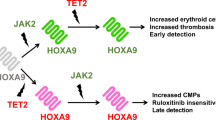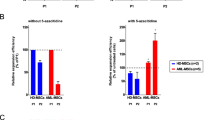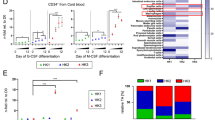Abstract
HOX genes have shown a lineage-specific expression in hematopoiesis and are suggested as being involved in the expression of certain adhesion molecules. Recently, we have demonstrated that HOXC4 and HOXC6, but not HOXC5, are expressed during lymphoid differentiation. Reports on the expression of these genes in myeloid leukemias and normal myeloid cells are still scarce. Therefore, we have investigated the expression of HOXC4, HOXC5 and HOXC6 in purified subpopulations of bone marrow in addition to 36 specimens of acute myeloid leukemias (AMLs), eight chronic myeloid leukemias (CMLs), several myeloid cell lines and cutaneous localizations of three myelomonocytic leukemias and one granulocytic sarcoma by RT-PCR and partly by RNA in situ hybridization (RISH). HOXC4 and HOXC6 transcripts were both detected by RT-PCR in 22/36 and 24/36 AMLs, respectively. The distribution of HOXC4 and HOXC6 gene expression over the different types of AML was largely similar and covered all types of AML. In contrast, HOXC5 gene expression was found in only 6/32 AMLs. Expression of HOXC5 was restricted to AMLs of the granulocytic (FAB M1–M3), early monocytic (FAB M4) and early erythroid (FAB M6) lineage. In general, except in one FAB M5b case, no expression of HOXC5 was found in AMLs derived from late stages of monocytic (FAB M5) and megakaryocytic (FAB M7) lineages. As for HOXC4 and HOXC6, expression of HOXC5 was absent in CMLs. Using RISH significant HOXC4, HOXC5 and HOXC6 expression was found in a number of additionally studied AML samples of different FAB classification (M2, M4, M5b and M5b), (M2 and M5b) (M2, M4, M5b), respectively. In tissue localizations of leukemias a different expression pattern of HOXC4, HOXC5 and HOXC6 was found. In contrast to mature leukemic stages of myeloid differentiation, these skin localizations of leukemias expressed HOXC5 and HOXC6. HOXC4 expression was found both in leukemic cells derived from peripheral blood and from cutaneous localizations. Besides HOXC4 expression in monocytes no expression of HOXC4, HOXC5 and HOXC6 was found in granulocytes and monocytes, colonies of growth factor-induced CD34+ bone marrow cells. In earliest CD34+/CD38low and high cell fractions of bone marrow only HOXC4 and in megakaryocytic cells both HOXC4 and HOXC6 were found. Thus, the expression patterns of these HOXC genes found in the limited number of cell fractions of normal bone marrow suggest that the expression patterns found in AMLs and CMLs might reflect the normal situation. Furthermore, the presence of HOXC5 and HOXC6 expression specifically in skin infiltrates of late differentiation stages of myeloid leukemias, suggests an additional role for these genes in the positioning of these myeloid cells in skin tissue.
This is a preview of subscription content, access via your institution
Access options
Subscribe to this journal
Receive 12 print issues and online access
$259.00 per year
only $21.58 per issue
Buy this article
- Purchase on SpringerLink
- Instant access to full article PDF
Prices may be subject to local taxes which are calculated during checkout
Similar content being viewed by others
Author information
Authors and Affiliations
Rights and permissions
About this article
Cite this article
Bijl, J., van Oostveen, J., Walboomers, J. et al. Differentiation and cell-type-restricted expression of HOXC4, HOXC5 and HOXC6 in myeloid leukemias and normal myeloid cells. Leukemia 12, 1724–1732 (1998). https://doi.org/10.1038/sj.leu.2401106
Received:
Accepted:
Published:
Issue date:
DOI: https://doi.org/10.1038/sj.leu.2401106
Keywords
This article is cited by
-
USP11 regulates proliferation and apoptosis of human spermatogonial stem cells via HOXC5-mediated canonical WNT/β-catenin signaling pathway
Cellular and Molecular Life Sciences (2024)
-
HOTAIR gene polymorphisms and risk of glioma in Chinese children
Current Medicine (2022)
-
Expression pattern of HOXB6 homeobox gene in myelomonocytic differentiation and acute myeloid leukemia
Leukemia (2002)
-
Alteration of maternal Hoxa10 expression by in vivo gene transfection affects implantation
Gene Therapy (2000)
-
BP1, a new homeobox gene, is frequently expressed in acute leukemias
Leukemia (2000)



